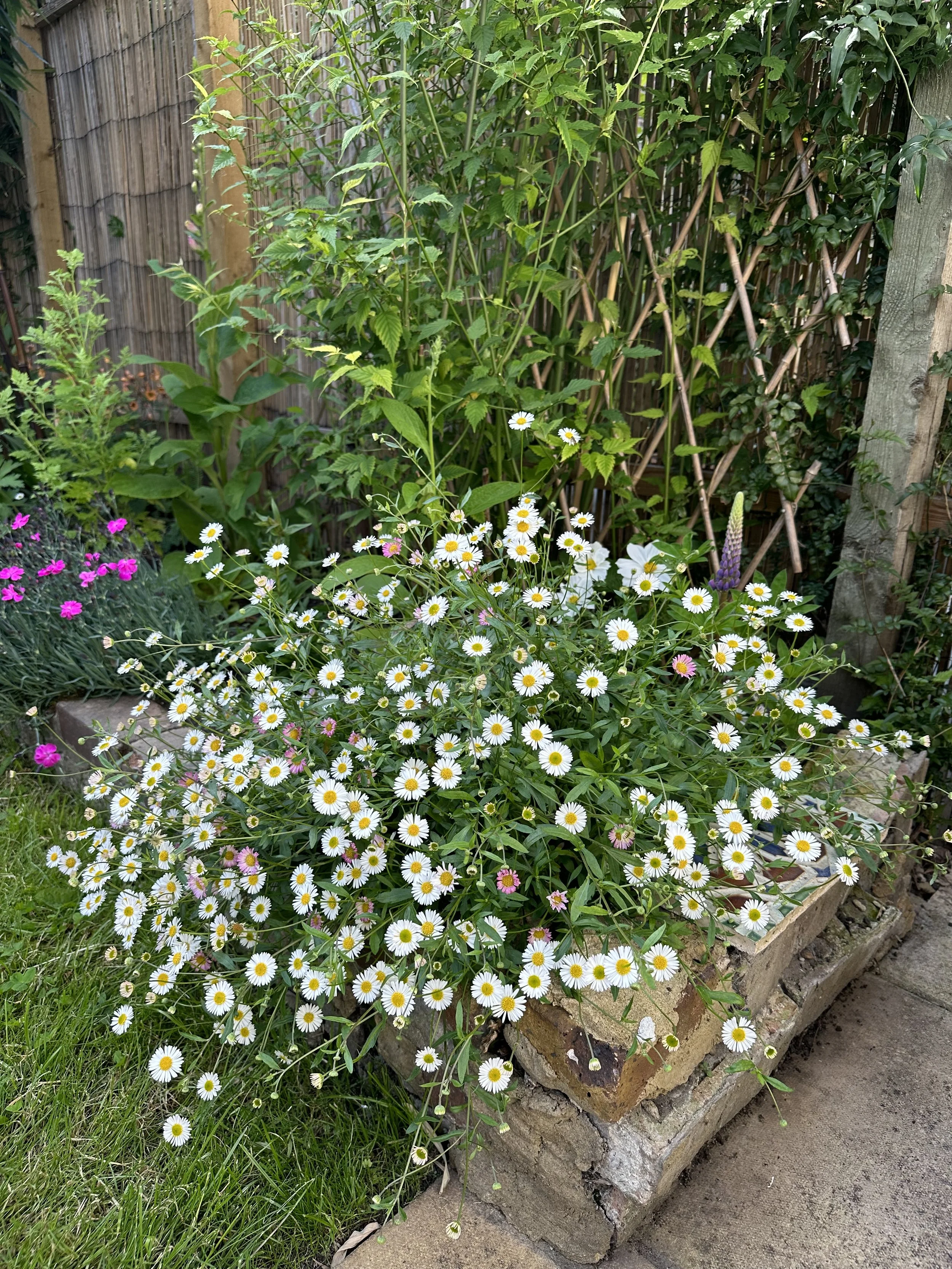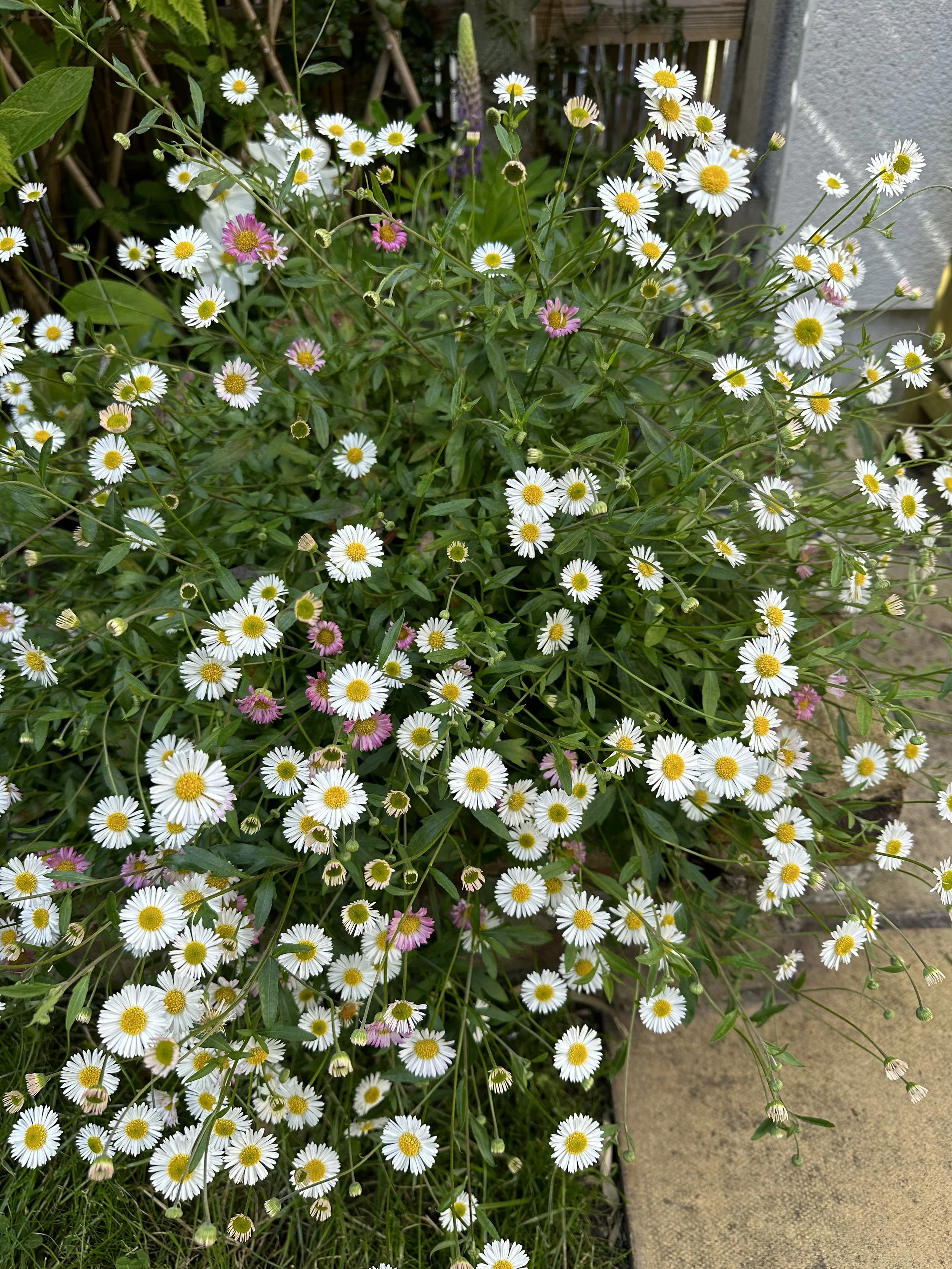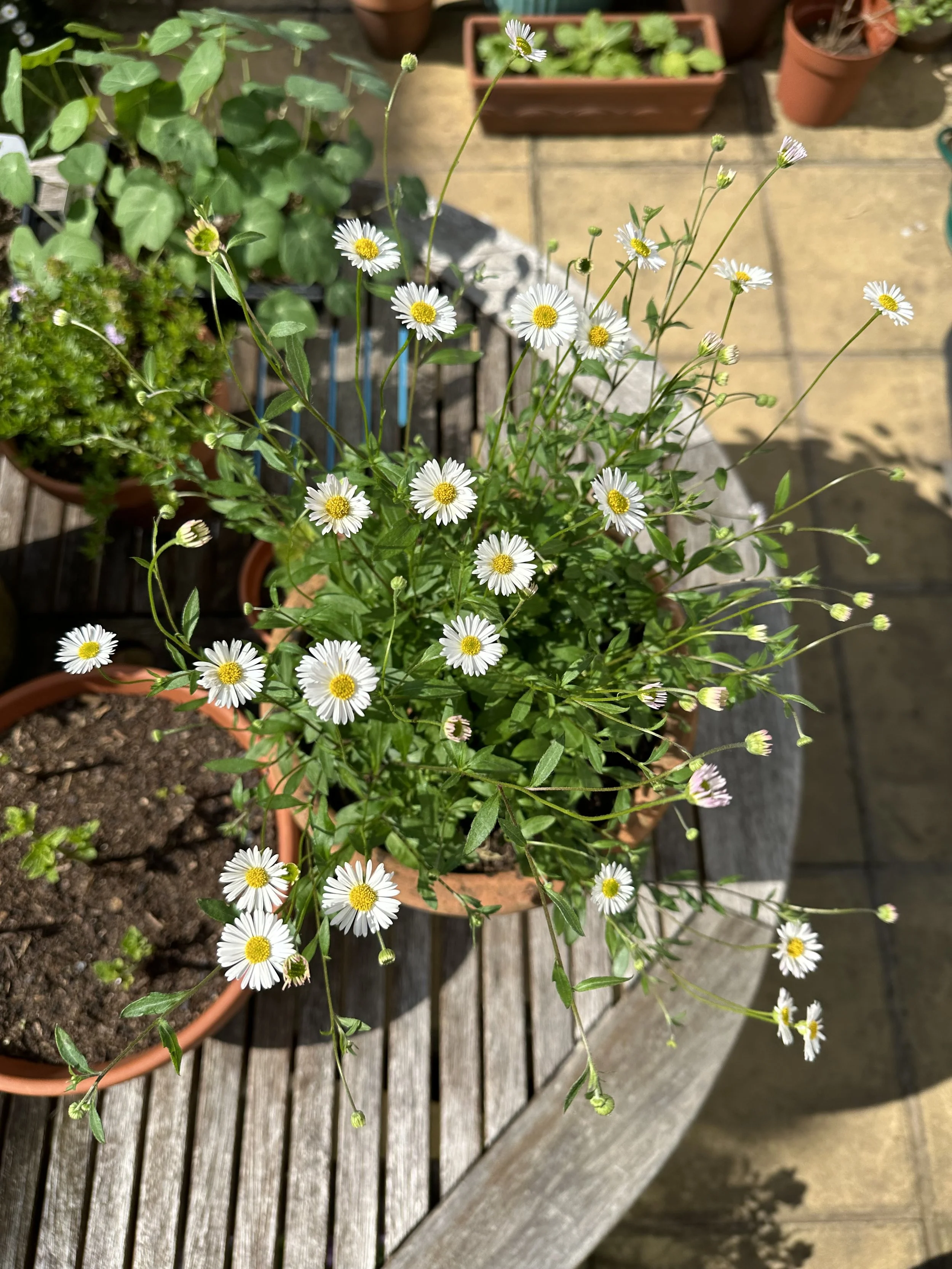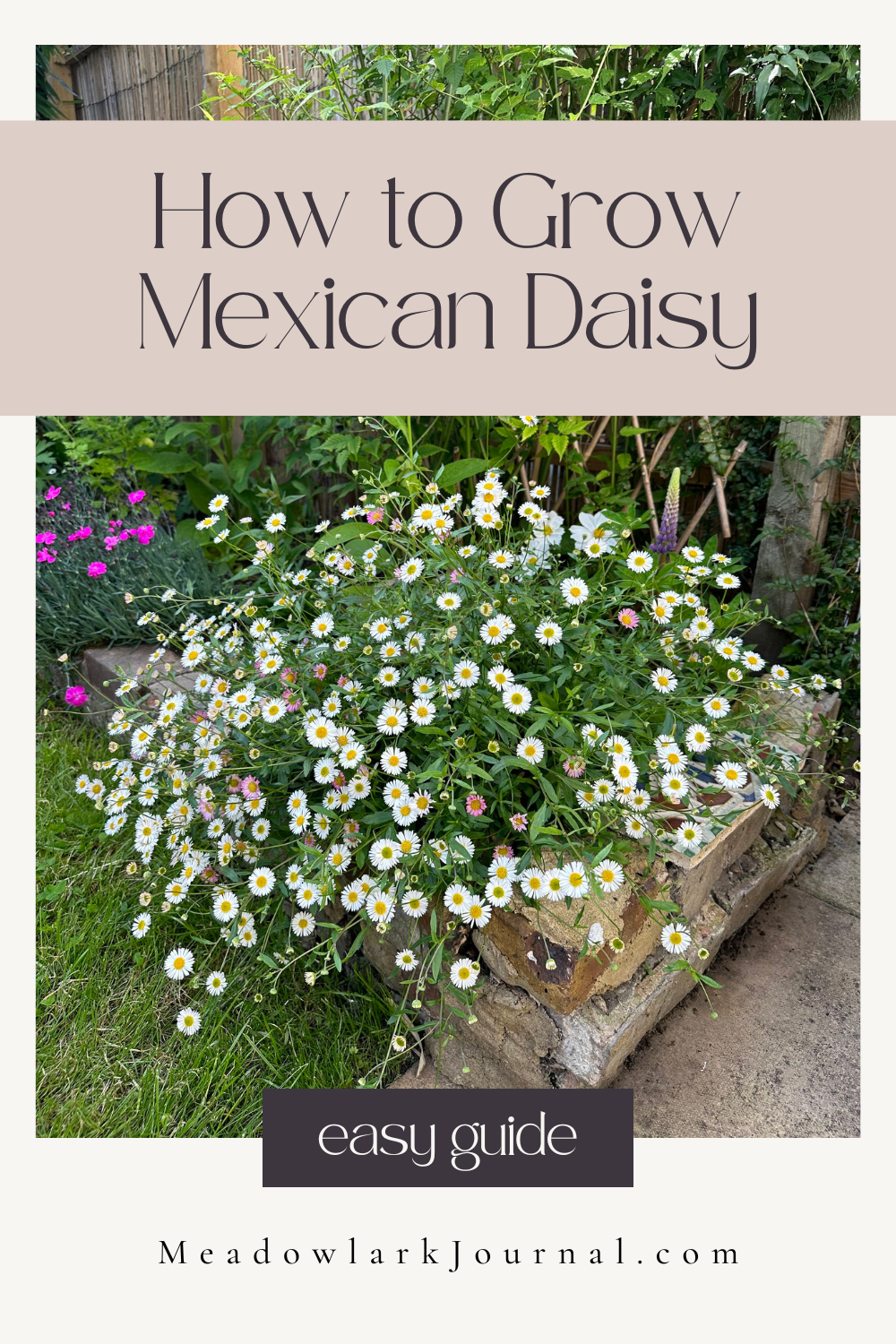How to Grow Mexican Daisy (Erigeron Karvinskianus)
This website is reader-supported - thank you! This post may contain affiliate links. As an Amazon Associate, I earn from qualifying purchases at no extra cost to you.
If you’re like me and love plants that practically take care of themselves, Mexican daisy (Erigeron karvinskianus) might just become one of your favorites.
These little daises, also called Santa Barbara daisies or Mexican fleabane, are a great addition to any garden.
I first spotted Mexican daisy at Kiftsgate Garden in the Cotswolds and have been growing it ever since.
Their blooms start out white, then shift to soft pink as they age, creating a border of soft color.
Plus, they’re low-maintenance and thrive in conditions where other plants might struggle.
Whether you want a ground cover to fill in bare spots or a pretty addition to a rock garden, Mexican daisies deliver without a fuss.
Here’s everything you need to know to grow them successfully.
For more flower growing tips, check out my guides:
Utilizing Nasturtium Companion Plants for Natural Pest Control
I love growing Mexican Daisy along my garden borders.
Choosing the Right Spot
Picking the perfect location for your Mexican daisies can make all the difference.
These plants love soaking up full sun, so look for a bright, sunny spot in your garden where they can bask in the light.
That said, if you live somewhere with scorching summers, a little partial shade during the hottest part of the day can help keep them happy.
Because they hail from Central America, Mexican daisies are used to warm, dry conditions, making them a great choice for low-maintenance gardens.
I’ve found they’re particularly beautiful along pathways or cascading over walls, where their delicate blooms create a soft, sort of whimsical look.
If you’ve got a bare patch or an area that could use a bit of charm, these daisies will gladly step up to the task.
My recommended pick for Erigeron Karvinskianus Seeds:
For more inspiration, check out my guides:
Preparing the Soil
Getting the soil just right might sound complicated, but trust me, Mexican daisies aren’t picky.
They’ll happily grow in anything from sandy soil to heavier clay, as long as it drains well.
If you’ve ever had a plant sulk in soggy soil, you’ll know why this is so important—these daisies love their roots to stay dry.
If you’re dealing with soil that tends to hold water, like heavy clay, you can mix in a bit of compost or grit to help with drainage.
I like to think of it as giving the soil a little boost to keep the daisies comfortable.
On the other hand, if your garden has naturally sandy or gravelly soil, you’re already ahead of the game.
What’s amazing about Mexican daisies is that they’re so forgiving.
They’ll even tolerate slightly nutrient-poor soils, which is great if you’re gardening in tough spots.
Just remember—good drainage is the secret to keeping these beauties happy.
For more ideas, check out my guides:
Planting Mexican Daisy
Planting Mexican daisies is really easy, and you have a few options to get started.
Whether you choose seeds, cuttings, or nursery plants, these daisies will quickly make themselves at home in your garden.
Seeds:
Starting from seeds is one of my favorite methods.
It’s simple, budget-friendly, and you get to watch the entire growing process unfold.
Sow the seeds directly in the garden in spring, once the frost has passed.
Scatter them lightly over the soil and gently press them in.
You don’t need to bury them deeply—they prefer a little sunlight to help with germination.
Keep the soil moist until the seedlings start to appear, and then let them settle in naturally.
Learn more: How Long Does it Take for Seeds to Germinate?
Cuttings:
If you already have Mexican daisies or know someone who does, softwood cuttings are a great way to expand your collection.
Take a cutting in late spring or summer and place it in moist soil.
With a little care and patience, you’ll notice roots forming in a few weeks.
It’s a fun way to grow new plants and share them with friends.
Nursery plants:
This is the quickest option if you want instant impact.
Pick up healthy nursery plants and transplant them into your garden.
Make sure to give them about 12 inches of space between each plant to allow for their natural spread.
It’s incredible how quickly they can fill in an area!
For more garden tips, check out my guides:
The Best Gardening Tool Sets for Every Gardener
Plants That Deter Cats: A Natural Solution to Keep Cats at Bay
Watering and pruning
One of the best things about Mexican daisies is how easy they are to care for once they’re established.
When they’re young, I like to give them a little extra attention with regular watering to help them settle in.
But once they’ve grown some strong roots, they’re incredibly drought tolerant and only need occasional watering.
During dry spells, I recommend giving them a deep soak every couple of weeks.
Think of it as a treat to keep them refreshed rather than a strict routine.
Overwatering is one of the few things they don’t handle well, so it’s always better to err on the side of less water.
When it comes to pruning, a little trimming goes a long way.
In late winter or early spring, I like to cut them back to encourage fresh growth and more blooms.
If you want to keep them looking tidy or control their spread, deadheading is your best friend.
Removing spent flowers not only keeps them neat but also prevents them from self-seeding too enthusiastically.
Honestly, these plants almost take care of themselves, which is one of the reasons they’re a favorite in my garden.
Whether you’re a hands-off gardener or someone who loves to fuss over plants, Mexican daisies will happily thrive with minimal effort.
Mexican daisy works great in a window box.
For more window box tips, check out my guide:
Companion Planting
Mexican daisies are team players in the garden, and they shine even brighter when paired with the right companions.
I love combining them with lavender and rosemary for a Mediterranean-inspired look that thrives in dry conditions.
The contrast between the soft daisy blooms and the bold structure of succulents like sedum or echeveria is another stunning option.
If you have taller perennials like Echinacea or Geums, Mexican daisies make the perfect ground cover, filling in the gaps with their delicate, trailing habit.
Their ability to soften edges and spill over borders makes them ideal for pathways or rock gardens.
What’s great about these combinations is that all the plants share similar water and sunlight needs, so you’re not juggling competing care routines.
Plus, the varied textures and colors create a layered, eye-catching effect that looks like you spent hours planning it—even if you didn’t.
Whether you want a garden that’s wild and natural or tidy and organized, Mexican daisies fit right in, bringing a touch of effortless beauty to the mix.
For more companion planting ideas, check out my guides:
Zinnia Companion Plants: Enhancing Biodiversity
FAQs
What is the origin of the name ‘Mexican daisy’?
The name reflects the plant’s native range, which includes parts of Mexico and Central America.
Its Latin name, Erigeron karvinskianus, honors a German botanist, Wilhelm von Karwinsky.
The term "Mexican daisy" is commonly used because the plant is so prevalent in those regions, adapting easily to the environment.
Can Mexican daisies grow in containers?
Absolutely!
Mexican daisies thrive in pots or containers, making them a fantastic choice for patios, balconies, or small spaces.
Just make sure the container has drainage holes to prevent water from sitting at the roots.
Use well-draining potting soil and place the container in a spot that gets plenty of sunlight.
Remember to water sparingly—these daisies don't like overly wet conditions.
When do Mexican daisies bloom?
Mexican daisies bloom from spring through fall, producing a profusion of flowers in shades of white and pink.
The flowers start white and gradually fade to pink, giving the plant a multicolored appearance as the blooms age.
Are Mexican daisies invasive?
In some areas, particularly in regions with mild winters, Mexican daisies can be considered invasive because they self-seed readily.
However, this trait can be managed with regular deadheading and trimming.
If you're worried about them spreading too much, grow them in pots or use natural barriers to keep them contained.
What are other names for Mexican daisy?
Mexican daisy is also known by several other names, including Santa Barbara daisy, seaside daisy, Spanish daisy, and Mexican fleabane.
These names often reference the plant’s ability to thrive in coastal and arid climates.
Is Mexican daisy (Erigeron karvinskianus) a weed?
While some gardeners may refer to Mexican daisy as a "weed," this is usually due to its tendency to self-seed and spread quickly.
In the right setting, it’s a low-maintenance ground cover that adds charm and color.
If it starts growing where you don’t want it, it’s easy to pull up or manage with trimming.
Its adaptability can be a blessing or a mild nuisance, depending on how you prefer your garden to look.
Looking for more garden inspiration? Check out my other flower garden guides:
Pin this post to save it for later!






































